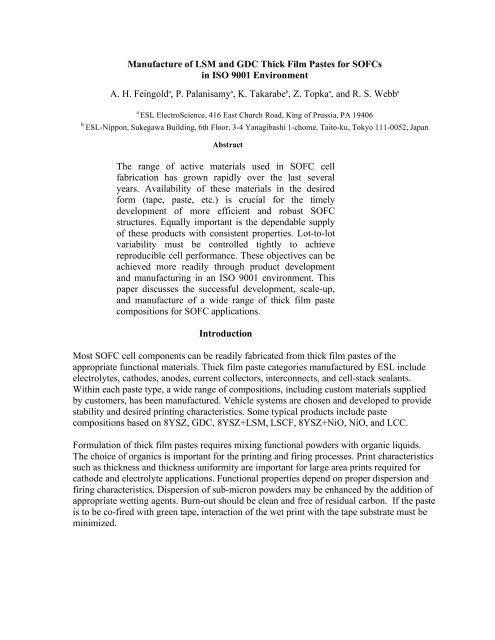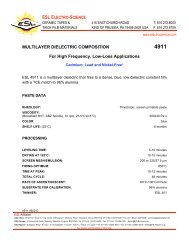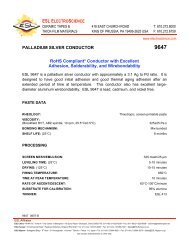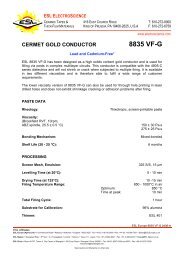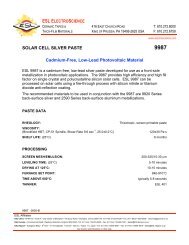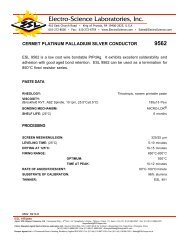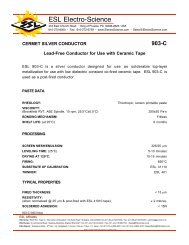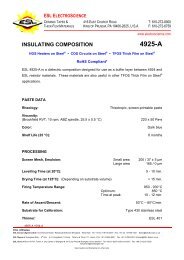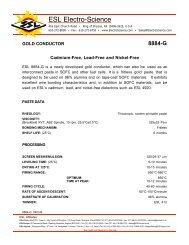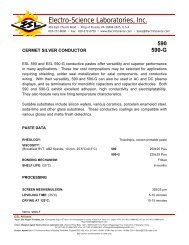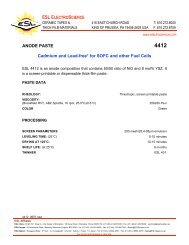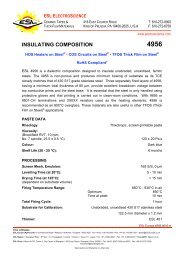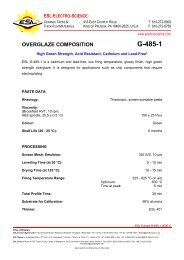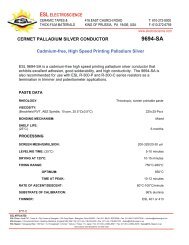Manufacture of LSM and GDC Thick Film Pastes for SOFCs in ISO ...
Manufacture of LSM and GDC Thick Film Pastes for SOFCs in ISO ...
Manufacture of LSM and GDC Thick Film Pastes for SOFCs in ISO ...
You also want an ePaper? Increase the reach of your titles
YUMPU automatically turns print PDFs into web optimized ePapers that Google loves.
<strong>Manufacture</strong> <strong>of</strong> <strong>LSM</strong> <strong>and</strong> <strong>GDC</strong> <strong>Thick</strong> <strong>Film</strong> <strong>Pastes</strong> <strong>for</strong> <strong>SOFCs</strong><strong>in</strong> <strong>ISO</strong> 9001 EnvironmentA. H. Fe<strong>in</strong>gold a , P. Palanisamy a , K. Takarabe b , Z. Topka a , <strong>and</strong> R. S. Webb aaESL ElectroScience, 416 East Church Road, K<strong>in</strong>g <strong>of</strong> Prussia, PA 19406b ESL-Nippon, Sukegawa Build<strong>in</strong>g, 6th Floor, 3-4 Yanagibashi 1-chome, Taito-ku, Tokyo 111-0052, JapanAbstractThe range <strong>of</strong> active materials used <strong>in</strong> SOFC cellfabrication has grown rapidly over the last severalyears. Availability <strong>of</strong> these materials <strong>in</strong> the desired<strong>for</strong>m (tape, paste, etc.) is crucial <strong>for</strong> the timelydevelopment <strong>of</strong> more efficient <strong>and</strong> robust <strong>SOFCs</strong>tructures. Equally important is the dependable supply<strong>of</strong> these products with consistent properties. Lot-to-lotvariability must be controlled tightly to achievereproducible cell per<strong>for</strong>mance. These objectives can beachieved more readily through product development<strong>and</strong> manufactur<strong>in</strong>g <strong>in</strong> an <strong>ISO</strong> 9001 environment. Thispaper discusses the successful development, scale-up,<strong>and</strong> manufacture <strong>of</strong> a wide range <strong>of</strong> thick film pastecompositions <strong>for</strong> SOFC applications.IntroductionMost SOFC cell components can be readily fabricated from thick film pastes <strong>of</strong> theappropriate functional materials. <strong>Thick</strong> film paste categories manufactured by ESL <strong>in</strong>cludeelectrolytes, cathodes, anodes, current collectors, <strong>in</strong>terconnects, <strong>and</strong> cell-stack sealants.With<strong>in</strong> each paste type, a wide range <strong>of</strong> compositions, <strong>in</strong>clud<strong>in</strong>g custom materials suppliedby customers, has been manufactured. Vehicle systems are chosen <strong>and</strong> developed to providestability <strong>and</strong> desired pr<strong>in</strong>t<strong>in</strong>g characteristics. Some typical products <strong>in</strong>clude pastecompositions based on 8YSZ, <strong>GDC</strong>, 8YSZ+<strong>LSM</strong>, LSCF, 8YSZ+NiO, NiO, <strong>and</strong> LCC.Formulation <strong>of</strong> thick film pastes requires mix<strong>in</strong>g functional powders with organic liquids.The choice <strong>of</strong> organics is important <strong>for</strong> the pr<strong>in</strong>t<strong>in</strong>g <strong>and</strong> fir<strong>in</strong>g processes. Pr<strong>in</strong>t characteristicssuch as thickness <strong>and</strong> thickness uni<strong>for</strong>mity are important <strong>for</strong> large area pr<strong>in</strong>ts required <strong>for</strong>cathode <strong>and</strong> electrolyte applications. Functional properties depend on proper dispersion <strong>and</strong>fir<strong>in</strong>g characteristics. Dispersion <strong>of</strong> sub-micron powders may be enhanced by the addition <strong>of</strong>appropriate wett<strong>in</strong>g agents. Burn-out should be clean <strong>and</strong> free <strong>of</strong> residual carbon. If the pasteis to be co-fired with green tape, <strong>in</strong>teraction <strong>of</strong> the wet pr<strong>in</strong>t with the tape substrate must bem<strong>in</strong>imized.
<strong>Thick</strong> <strong>Film</strong> Paste Materials SystemCathode <strong>Pastes</strong>.Compositions required <strong>for</strong> cathode applications must per<strong>for</strong>m two ma<strong>in</strong> functions after fir<strong>in</strong>g.They must be catalytic to the trans<strong>for</strong>mation <strong>of</strong> oxygen molecules to oxygen ions. They alsomust be electrically conductive <strong>in</strong> oxidiz<strong>in</strong>g atmosphere at high (650-900°C) temperatures.The fired cathode must also reta<strong>in</strong> enough porosity to <strong>in</strong>sure gas-flow to <strong>and</strong> from theelectrolyte. Oxygen, <strong>in</strong> the <strong>for</strong>m <strong>of</strong> air must traverse the cathode while be<strong>in</strong>g trans<strong>for</strong>med tooxygen ions, which diffuse through the electrolyte to react with the hydrogen <strong>and</strong> carbonmonoxide on the anode side. The cathode paste must have a structure, which ensures thistrans<strong>for</strong>mation while reta<strong>in</strong><strong>in</strong>g its porosity <strong>and</strong> electrical conductivity. Powder morphology,particle size, <strong>and</strong> chemical <strong>in</strong>tegrity are all important properties that must be carried throughthe process <strong>of</strong> manufactur<strong>in</strong>g the thick film paste.Anode Compositions.Anode pastes have similar requirements. The anode, typically reduced NiO <strong>in</strong> a NiO-YSZcomposite, provides the catalytic action to re<strong>for</strong>m the fuel gas to hydrogen <strong>and</strong> carbonmonoxide. Electrical conductivity <strong>and</strong> porosity <strong>of</strong> this structure are also critical. Animportant SOFC configuration be<strong>in</strong>g the anode-supported cell, mechanical strength <strong>of</strong> theanode structure must be high enough <strong>for</strong> cell stack assembly. The addition <strong>of</strong> YSZ to theanode structure also adjusts the coefficient <strong>of</strong> thermal expansion (CTE) <strong>of</strong> the structure toenhance stability dur<strong>in</strong>g thermal cycl<strong>in</strong>g. The ratio <strong>of</strong> metal to ceramic, with the possible<strong>in</strong>clusion <strong>of</strong> a fugitive pore <strong>for</strong>mer, will determ<strong>in</strong>e the efficient functionality <strong>of</strong> the anode.Anode pastes must be <strong>for</strong>mulated to satisfy all <strong>of</strong> these requirements. Excellent dispersion<strong>and</strong> stability <strong>of</strong> these phases <strong>in</strong> the paste is required to <strong>in</strong>sure optimum per<strong>for</strong>mance <strong>of</strong> thecomposite fired anode.Electrolyte Compositions.Although most electrolytes are <strong>for</strong>med from tape cast YSZ, electrolyte pastes are also used <strong>in</strong>some cases. This element <strong>of</strong> the cell must be dense, th<strong>in</strong>, uni<strong>for</strong>m <strong>in</strong> thickness, <strong>and</strong> becompletely free <strong>of</strong> connected porosity to <strong>in</strong>sure optimum functionality. Eight mol percentyttria is most typical, but high ionic conductivity may be compromised to enhance strengthwith lower levels <strong>of</strong> yttria. Yttria may be replaced with Sc<strong>and</strong>ia to <strong>in</strong>crease ionic conductivityat lower operat<strong>in</strong>g temperatures. Other electrolytes, <strong>in</strong>clud<strong>in</strong>g gadol<strong>in</strong>ia doped ceria mayalso be <strong>for</strong>mulated.Interconnect Materials.<strong>Thick</strong> films are also used <strong>in</strong> the <strong>in</strong>terconnect region <strong>of</strong> the cell as current collectors. Thesemust be <strong>for</strong>mulated to <strong>in</strong>sure a fired structure that can withst<strong>and</strong> the high temperatureoperat<strong>in</strong>g conditions <strong>in</strong> both oxidiz<strong>in</strong>g <strong>and</strong> reduc<strong>in</strong>g atmospheres as well as the thermalcycl<strong>in</strong>g required <strong>in</strong> most applications. Plat<strong>in</strong>um <strong>in</strong>ks work very well as current collectors, but
are expensive. Replacement <strong>of</strong> plat<strong>in</strong>um with lower cost alloys <strong>and</strong> perovskites, is the focuson many ongo<strong>in</strong>g R&D programs. These <strong>in</strong>clude doped chromites such as LCC <strong>and</strong> LSCC.Stack Seals.One <strong>of</strong> the most challeng<strong>in</strong>g technical aspects <strong>of</strong> stack build<strong>in</strong>g is the <strong>for</strong>mation <strong>of</strong> a robustseal between cells. Electrical <strong>in</strong>sulation must be reta<strong>in</strong>ed at operat<strong>in</strong>g temperatures <strong>in</strong> bothoxidiz<strong>in</strong>g <strong>and</strong> reduc<strong>in</strong>g atmospheres after thermal cycl<strong>in</strong>g. Mobile applications <strong>of</strong> fuel cellsmay require tens <strong>of</strong> thous<strong>and</strong>s <strong>of</strong> cycles. Even stationary power supplies will requirehundreds <strong>of</strong> thermal cycles. The seal materials must match CTE <strong>of</strong> the gas manifolds if theyare to survive these cycles. <strong>Thick</strong> film process <strong>of</strong>fer the ability to <strong>in</strong>expensively <strong>and</strong>reproducibly <strong>for</strong>mulate these compositions. Many glass <strong>and</strong> glass ceramic compositions arebe<strong>in</strong>g developed, which survive <strong>in</strong>creas<strong>in</strong>g number <strong>of</strong> thermal cycles.Flexible CompositionsA major advantage <strong>of</strong> <strong>for</strong>mulat<strong>in</strong>g thick film paste compositions is the ability to modify thecomposition even after the paste is made. Start<strong>in</strong>g from end members, virtually a cont<strong>in</strong>uousseries <strong>of</strong> <strong>in</strong>termediate compositions can be made by simply blend<strong>in</strong>g multiple end members.Another benefit <strong>of</strong> us<strong>in</strong>g paste materials is that even very small quantities <strong>of</strong> rare rawmaterials can be converted to pastes <strong>for</strong> evaluation purposes.Paste Manufactur<strong>in</strong>g Quality System<strong>LSM</strong> <strong>and</strong> <strong>GDC</strong> thick film pastes <strong>for</strong> solid oxide fuel cells are be<strong>in</strong>g developed <strong>in</strong> laboratoriesall over the world. As new <strong>for</strong>mulations are developed, evaluated, <strong>and</strong> improved, it isimportant to be able to reproduce them. An <strong>ISO</strong> 9001 management system helps ensure thatthis happens. Un<strong>for</strong>tunately, the discipl<strong>in</strong>es <strong>of</strong> <strong>ISO</strong> 9001 do not exist <strong>in</strong> most laboratories.Where <strong>ISO</strong> 9001 certification is <strong>in</strong> place, the use <strong>of</strong> documented <strong>for</strong>mulas <strong>and</strong> procedures isrequired. Documentation is developed with the <strong>in</strong>itial development <strong>of</strong> any new product orprocess. Any changes that are made dur<strong>in</strong>g the development process are tracked <strong>and</strong>documented.Raw Materials H<strong>and</strong>l<strong>in</strong>g.The process starts with the characterization <strong>of</strong> raw materials. Intermediates <strong>and</strong> f<strong>in</strong>al productproperties are monitored as part <strong>of</strong> the process. Control charts are ma<strong>in</strong>ta<strong>in</strong>ed <strong>for</strong> eachmeasurement <strong>and</strong> are used to set mean<strong>in</strong>gful specifications <strong>and</strong> monitor the suitability <strong>of</strong> rawmaterials. Measurement techniques are documented <strong>and</strong> gage repeatability <strong>and</strong>reproducibility (Gage R&R or GRR) studies are per<strong>for</strong>med. Statistical Gage R&R studiesdeterm<strong>in</strong>e the with<strong>in</strong>-system <strong>and</strong> between-system measurement variation <strong>for</strong> a givenmeasurement technique. Gage R&R studies enable us to m<strong>in</strong>imize the measurementvariation <strong>and</strong> ensure that measurements are mean<strong>in</strong>gful. Control charts <strong>for</strong> average particlesize <strong>and</strong> powder surface area <strong>for</strong> an <strong>LSM</strong> type powder are given <strong>in</strong> Figures 1 <strong>and</strong> 2,respectively.
1.61.51.41.31.21.1FSSS, !m1.00.90.80.70.6ABCCBAUCL=1.291Avg=0.959LCL=0.6280.50.40.3123456789101112131415161718Lot #Figure 1. Control chart <strong>for</strong> the average particle size <strong>of</strong> an <strong>LSM</strong> type powder7.06.56.05.55.0SSA, m2/g4.54.03.53.02.52.0ABCCBAUCL=5.431Avg=3.957LCL=2.4821.51.0123456789101112131415161718Figure 2. Control chart <strong>for</strong> the average surface area <strong>of</strong> an <strong>LSM</strong> type powder.Lot #Control Systems <strong>for</strong> Paste Manufactur<strong>in</strong>g.The manufactur<strong>in</strong>g process starts with the characterization <strong>of</strong> raw materials <strong>and</strong> cont<strong>in</strong>uesthrough <strong>in</strong>termediates to f<strong>in</strong>ished products. The flow <strong>of</strong> materials is controlled, tracked, <strong>and</strong>documented throughout the manufactur<strong>in</strong>g cycle. This applies equally well to new productdevelopment, facilitat<strong>in</strong>g ease <strong>of</strong> scale-up <strong>and</strong> subsequently an orderly <strong>and</strong> timely transitionto manufactur<strong>in</strong>g. Control charts are developed <strong>and</strong> ma<strong>in</strong>ta<strong>in</strong>ed <strong>for</strong> all paste parametersmeasured. Rigorous control <strong>of</strong> paste properties results <strong>in</strong> consistent pr<strong>in</strong>t<strong>in</strong>g <strong>and</strong> fir<strong>in</strong>gcharacteristics <strong>in</strong>clud<strong>in</strong>g thickness uni<strong>for</strong>mity, fired density, <strong>and</strong> fired porosity, whereappropriate. Control charts <strong>for</strong> two common but critical paste parameters, viscosity <strong>and</strong> solidscontent, <strong>for</strong> a product typical <strong>of</strong> <strong>LSM</strong> pastes are presented below.
330310Viscosity, Pa*s @ 10 RPM290270250230210190170ABCCBAUCL=293.03Avg=248.14LCL=203.261501234567891011121314151617181920212223242526272829303132333435Lot #Figure 3. Control chart <strong>for</strong> the viscosity <strong>of</strong> an <strong>LSM</strong> type paste.73.573.0% Solids72.572.071.5ABCCBAUCL=73.092Avg=72.442LCL=71.79171.01234567891011121314151617181920212223242526272829303132333435Lot #Figure 4. Control chart <strong>for</strong> the solids content <strong>of</strong> an <strong>LSM</strong> type paste.ConclusionPractic<strong>in</strong>g well established <strong>ISO</strong> 9001 total quality pr<strong>in</strong>ciples enables ESL to develop <strong>and</strong>manufacture high quality thick film paste products <strong>for</strong> SOFC applications consistently <strong>and</strong>economically.


